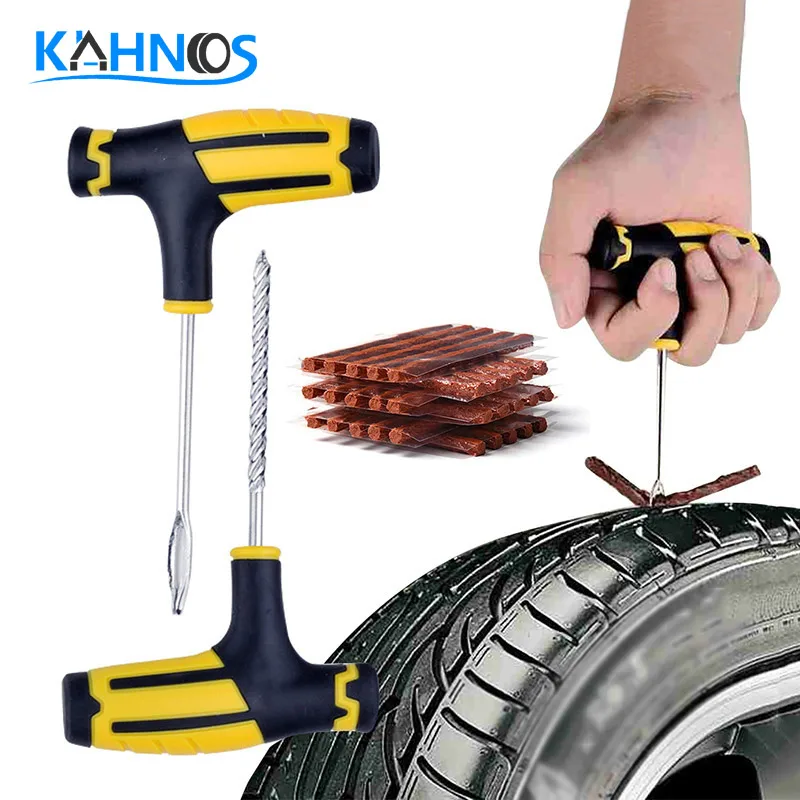The sealant used in a tubeless tyre setup is designed to quickly plug small holes, often without you even realising.
However, sometimes the size or the location of the puncture will require more than sealant to fix it.
Here’s how to repair a punctured tubeless tyre using tubeless plugs, patches or sewing.
Tubeless punctures are often easy to find: look for tell-tale sealant or listen for the hissing of lost air pressure.Immediate Media
These days, a tubeless plug kit is a key part of any rider’s tool kit.Steve Behr
To repair a tubeless tyre puncture, you will require
For a more serious or stubborn puncture, you may need a tyre patch and/or a needle and thread.
If your sealant has dried out, you might need to refresh it.Russel Burton
You may also require:
Tubeless puncture plugs are a quick and effective solution. With these, there is no need to take off the tyre – just plug, re-inflate and go.
While there are a number of tubeless repair kits out there, most work in a similar way, using a rubber plug to fill the hole.
Once you’ve found the puncture, remove any offending items (a pick or a small pair of pliers are a useful addition to your tool bag for this very purpose).
Next, use your tubeless plug tool to make sure there’s a sufficiently large hole for the plug to enter – carefully insert the spike into the tyre to avoid damaging the rim tape, and twist to give a clean, round hole.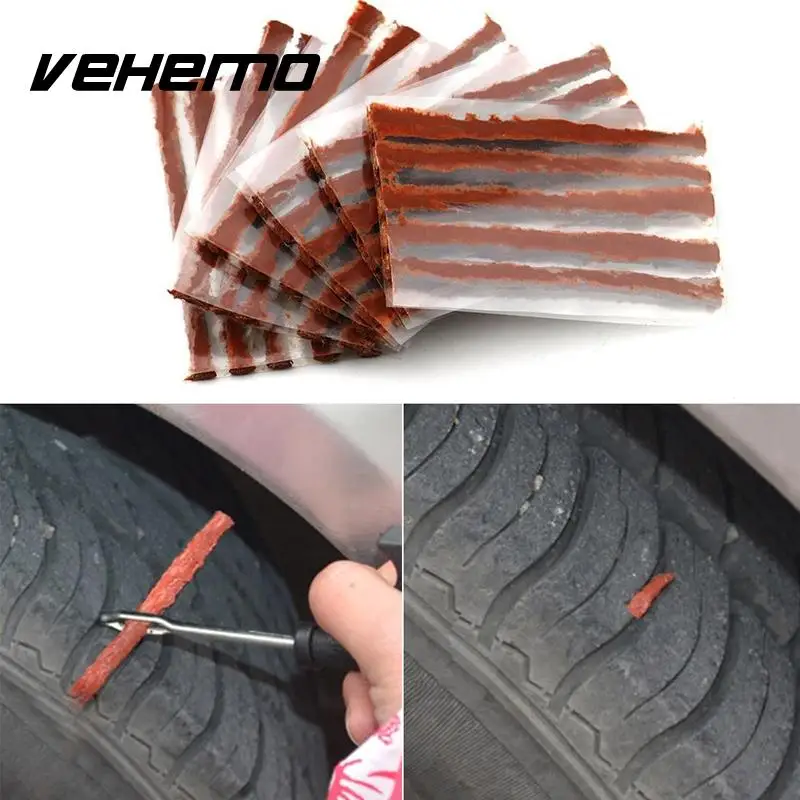
Thread a tubeless plug through the head of the tubeless plug tool. Most tools will come with a choice of different plug sizes to suit the size of the hole.
With the plug in the centre of the tool, insert it into the tyre, making sure you don’t push through fully.
Then twist carefully to slowly remove the tool, leaving the two ends of the plug on the outside of the tyre.
Inflate the tyre to your desired pressure, taking additional caution with high-pressure road tyres, and rotate the wheel so that the plug is at the ground for a few minutes before you get going again. This will allow some sealant to flow into the repair and fully seal things.
You may need to trim the tails of the plug that are left behind, but take care not to cut it too close to the tyre.
For more stubborn tubeless tyre punctures that can’t be fixed with a plug, it may be necessary to patch the tyre internally. The process for this is very similar to patching an inner tube.
First, you’ll need to roughen the surface that you want your patch to adhere to, using a little sandpaper, making sure there’s no debris left from the puncture. Cleanliness is key when it comes to gluing patches.
Add some vulcanising rubber solution to the area where you want to add the patch, waiting for it to become tacky as per the kit instructions.
Add the tubeless tyre patch and press down firmly. Try to avoid touching the surface that is to be glued because this can contaminate the adhesive.
Depending on the patch type, these may need minutes or hours to dry, before setting the tyre up tubeless as normal.
If successful, a patched tubeless tyre can last for many rides, often to the end of the tyre’s life.
A torn tyre can be a rider’s worst nightmare. These repair options should be viewed as a way to help you limp home before fitting a new tyre, rather than a long term solution.
A tyre boot can be placed on the interior of the tyre without any adhesive, held in place by the addition of an inner tube.
This flat boot keeps a flush internal surface to prevent the inner tube from bulging out of the slashed tyre. You can buy pre-made boots or make one out of a number of materials: toothpaste tubes, a section of inner tube or cash notes all work surprisingly well.
You’ll need a strong thread and needle to sew a tyre, such as this thick nylon or tooth floss.Immediate Media
If you don’t have a boot but you do happen to have tooth floss and a needle, you can actually sew up a torn tubeless tyre.
Using stitches perpendicular to the direction of the slash can help hold the casing of the tyre together before you insert an inner tube.
If you do use this method, it’s a good idea to add something between the sewn rubber and inner tube, such as a strip of strong tape.
If you are heading to the hills for an extended bikepacking or touring trip, packing a needle and thread is a good idea for this and any other fabric repairs.
No matter how hard you try, there’s always the chance a tubeless tyre might not be fixable on the road or trailside. Inserting an inner tube can be a mucky business with sealant already in the tyre, so it’s generally a last resort.
Before fitting an inner tube, thoroughly check the tyre for any punctures or offending items such as thorns. Just because you’ve found one, doesn’t mean there won’t be more embedded in the rubber waiting to puncture your inner tube too!
You can still get snakebite punctures with tubeless too, so make sure you’re running adequate pressures in your tyres, especially over harsh or rocky terrain to avoid a nasty double puncture from an impact on the rim. These are notoriously tricky to fix, with holes often too close to the tyre bead.
Besides punctured tyres, there are other things that need careful maintenance to keep your tubeless set up running smoothly, including the rim tape, tubeless valves and sealant.
It can be pretty hard to sort these on the go, so that’s when you might need to pop in a tube and leave the closer inspection until you’re home.
Katherine Moore is Bristol-based gravel and bikepacking expert who judges her rides by stoke level, rather than speed. When she’s not scouting out the best long-distance and local off-road routes in the UK, Katherine works as a freelance writer, bike tester, presenter and guide. Katherine is the former editor of advntr.cc and has also worked as a presenter on the Global Cycling Network. As well as being a regular contributor to BikeRadar.com and the BikeRadar Podcast, Katherine has also written for Cycling Weekly, Bikepacking.com and hosts the Unpaved Podcast. If you’re out on the trail you’ll likely see her from a mile off, thanks to her rather bright colour palette!
Considering a tubeless tire setup for a long international trip? Or just hoping to have flatless bikepacking outings in your own backyard? Here’s our complete field guide to tubeless with a full tubeless tire repair kit, how-to videos for repair and setup, plugger options, and tips from the road…
compose Team Work
time Jun 19, 2020
comment 79
Despite the fact that most of the mainstream mountain bike world has converted, many bikepackers and bike tourers remain cautiously hesitant to transition to a tubeless setup, especially for big long-distance trips.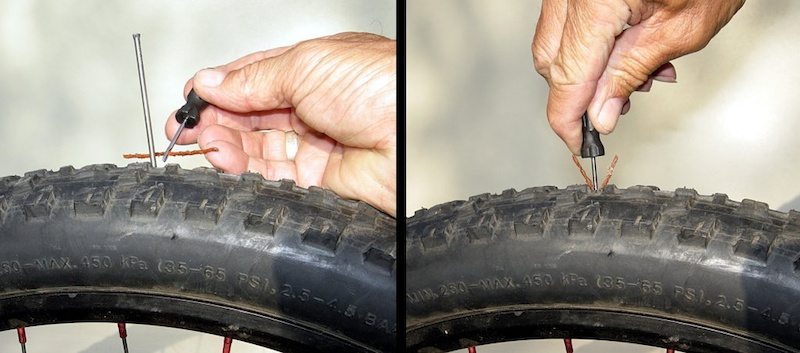 We get it. For folks who haven’t performed their own tubeless conversion, it can seem like a daunting task. To some, it remains a dark art… or at least, a complicated operation that requires special skills, a compressor, and general mechanical savvy to successfully complete.
We get it. For folks who haven’t performed their own tubeless conversion, it can seem like a daunting task. To some, it remains a dark art… or at least, a complicated operation that requires special skills, a compressor, and general mechanical savvy to successfully complete.
Tubeless Tire Setup
Tubeless Tire Repair
Tubeless Tire Repair Kit
Pluggers
Tips for Traveling Tubeless
But we’ve put this guide together in hopes of convincing you otherwise. In our opinion, tubes have long been dead. Just go for a long dirt road tour in South Africa. Or spend a few days out on the Arizona Trail. Or bomb down a rocky trail in backcountry Peru. Never having flats rules… period. Combined with the ability to run lower tire pressures for a more compliant ride—especially given the popularity of larger volume tires and wider rims these days—we think everyone should be running tubeless tires at this point. Not only are most rims and tires now optimized for tubeless, many new bikes are ready to convert, or are already tubeless out of the box. In addition, there’s a multitude of great tubeless repair tools and pluggers on the market, making repairs easy once you have the basics down.
Not only are most rims and tires now optimized for tubeless, many new bikes are ready to convert, or are already tubeless out of the box. In addition, there’s a multitude of great tubeless repair tools and pluggers on the market, making repairs easy once you have the basics down.
To help demystify the whole process, here’s our full field guide with videos, tips, tricks, and a full tubeless repair kit to get you started and keep you rolling. We encourage you to give it a try; experience is more valuable than anything. Further down the post, you’ll also find two full video guides that we put together. But first, some basics on tires and rims.
Although most modern rims are “tubeless ready” these days, there are still new bikes that get specced rims that are not. The most prevalent feature on a tubeless ready rim is that the rim bed features bead-locks, or small ridges in the flat section of the rim profile that help prevent burping (when the bead momentarily breaks and air is burped out). Meanwhile, a properly designed center channel makes a loosely mounted tire “grab” air and snap over the bead locks. The latter is the key to their ease of tubeless tire installation.
Meanwhile, a properly designed center channel makes a loosely mounted tire “grab” air and snap over the bead locks. The latter is the key to their ease of tubeless tire installation.
Although you can often use standard tires for a tubeless setup, a tubeless ready (TR) model will likely seal better due to its optimized bead design. You’ll appreciate this all the more when installation conditions aren’t optimal. TR tires also tend to have reinforced sidewalls; given that a tubeless tire is run at lower pressures and can be more susceptible to sidewall cuts, this is especially welcome. If TR models aren’t available to you, we prefer tires with lower TPI counts for long-distance travel.
Setting up your wheels and tires tubeless isn’t as difficult as you might think. Watch our video setup guide below, along with some tubeless setup tips. Also, scroll to the bottom of the page to find our step-by-step guide to setting up tires tubeless before and after flying with your bike.
Properly taping the rim is crucial to a successful tubeless setup. Start by cleaning the inside of the rim. Use rubbing alcohol or a degreaser to get any residue or factory finish off the rim. This ensures that the tape will stick. Use the widest tape possible to fit in the face of the rim. As for brands, WTB TCS tape works well and comes in several widths. With the disc rotor facing you, tape the rim in a clockwise rotation, which allows the force of the tire sealant liquid to not agitate the tape seam (the clockwise rotation of the wheel will generally allow the liquid to flow over the seal and not against it). Start the tape on the face opposite the valve stem hole and allow a 1” to 2″ overlap. After taping, carefully cut a smooth hole for the valve stem using a sharp blade.
For a tubeless tape job that lasts, we highly recommend mounting the tire with a tube inside before setting it up with tubeless sealant. Doing so ensures that the tape fully seals to the rim and keeps sealant from penetrating under the tape and causing it to peel up over time. Inflate the tube to the typical maximum pressure recommended for your tires and let it sit overnight. The next day, unseat one side of the tire and remove the tube. This helps the tire create the “memory” of its shape, which aids in the initial setup. Here’s a nice and clear how-to video from WTB for reference.
Doing so ensures that the tape fully seals to the rim and keeps sealant from penetrating under the tape and causing it to peel up over time. Inflate the tube to the typical maximum pressure recommended for your tires and let it sit overnight. The next day, unseat one side of the tire and remove the tube. This helps the tire create the “memory” of its shape, which aids in the initial setup. Here’s a nice and clear how-to video from WTB for reference.
Here’s our full video guide to tubeless tire repair. Watch it, then scroll down to find important tips, tools, and other information.
This is a useful skill to acquire, given that some tubeless tires are more prone to sidewall failures than regular ones. This is especially important when planning a desert adventure, where jumbles of razor-sharp rocks often abound. Tire plugs will repair most cuts; use them with the tool provided to blot a tire wound. To fix larger cuts without unseating the tire, carry a heavy, curved needle and a length of dental floss to sew the cut up first. A dab of superglue over the dental floss is recommended. For longer, 2” to 3” gashes, add a section of sidewall cut out from an old tire, using Shoe Goo (REI sells small containers) to glue in the boot after sewing the cut. Let the glue dry overnight with an inflated tube in place to hold pressure on it–it’s rare to have a cut so bad that you can’t wait till night to do this. If your repair won’t hold, make sure you have a couple of inner tubes on hand. Just be sure to remove all the thorns from the casing before you fit it!
Tire plugs will repair most cuts; use them with the tool provided to blot a tire wound. To fix larger cuts without unseating the tire, carry a heavy, curved needle and a length of dental floss to sew the cut up first. A dab of superglue over the dental floss is recommended. For longer, 2” to 3” gashes, add a section of sidewall cut out from an old tire, using Shoe Goo (REI sells small containers) to glue in the boot after sewing the cut. Let the glue dry overnight with an inflated tube in place to hold pressure on it–it’s rare to have a cut so bad that you can’t wait till night to do this. If your repair won’t hold, make sure you have a couple of inner tubes on hand. Just be sure to remove all the thorns from the casing before you fit it!
Although one tube is often enough, we’d always recommend carrying at least two spare inner tubes when heading overseas, especially if you’re running an unconventional tire size. Generally speaking, your spare tubes can be ultralight models, as it’s unlikely they’ll be needed.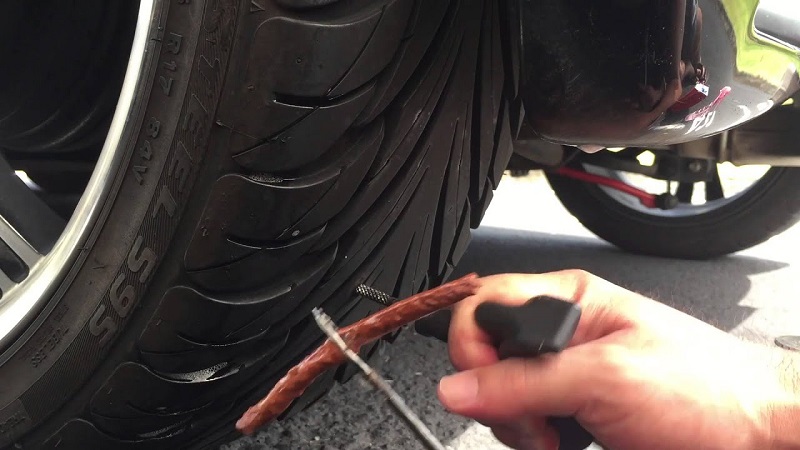 Just make sure you baby them! It’s easy to leave them languishing in the bottom of a frame bag, where they’re prone to abrasion. We wrap one in tape and attach it to the bike, and store another in a thin sock for protection. Some use a ziploc bag with baby powder, as legend has it a little talc allows the tube to move inside the tire, and may help eliminate pinch flats from twisted during installation. If and when they’re needed, be sure to check your tire thoroughly first. Most likely, it will be riddled with thorns or other debris. In a pinch, you can always run conventional 26” tubes on a 29er, or even a fat bike.
Just make sure you baby them! It’s easy to leave them languishing in the bottom of a frame bag, where they’re prone to abrasion. We wrap one in tape and attach it to the bike, and store another in a thin sock for protection. Some use a ziploc bag with baby powder, as legend has it a little talc allows the tube to move inside the tire, and may help eliminate pinch flats from twisted during installation. If and when they’re needed, be sure to check your tire thoroughly first. Most likely, it will be riddled with thorns or other debris. In a pinch, you can always run conventional 26” tubes on a 29er, or even a fat bike.
We’ve posted a full-blown bikepacking repair kit in the past, but here’s the tire repair kit of the future. Start by thinking less about tubes and more about repairing your tires and keeping them sealed.
Although this may vary depending on tire volume, we recommend carrying 2oz of sealant for small day rides or overnighters, at least 4oz of sealant for trips up to a few weeks, or for extra long trips, make it 8oz. Orange Seal comes in handy 4oz injector bottles. Orange Seal Endurance is a favorite for several of us here.
Orange Seal comes in handy 4oz injector bottles. Orange Seal Endurance is a favorite for several of us here.
Always carry at least one tube. To be ultra safe or for longer trips, carry two. And as mentioned above, be sure to take extra care of it by storing it in a Ziploc bag.
Roll a dozen or so winds around your pump. Gorilla tape can be used to help with a tire tear or to re-tape a rim, in addition to a ton of other miscellaneous uses around camp.
Carrying a patch kit is a must. In the event of having to use a tube, you’ll likely need to patch it down the road, particularly if you are traveling through desert landscapes where thorns or goatherds are prevalent. Pro tip: make sure the cement isn’t dried out and the sandpaper is in good shape. Also, alongside a tube, we’ve used patches to seal small sidewall cuts, much like a tire boot.
Super glue or shoe glue can help aid in the repair of a tire tear in the tread area or sidewall.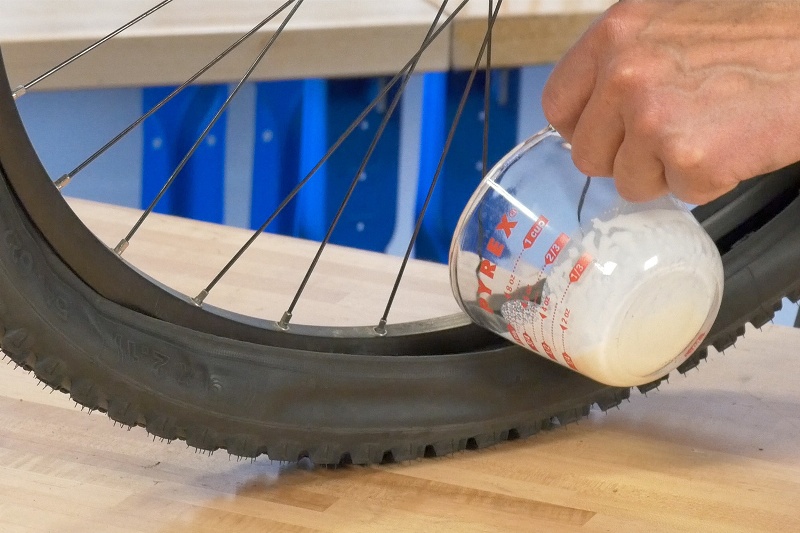 You can even put glue around a plug for additional support, or on the adhesive side of tape and create an ultra strong bond.
You can even put glue around a plug for additional support, or on the adhesive side of tape and create an ultra strong bond.
It’s easy to damage a valve, have one clog up, or even loose the core while working on a trailside repair. So, carry an extra. They’re small enough.
These work well for punctures that are too big for the sealant but not so big you need a boot. It should provide a permanent repair for most normal punctures. Find a full list of plugger options below. Also note that if you are out of plugs, you can wedge in bits of cloth, rope, or other sealant absorbing materials to stop a leak. This can be especially handy if the hole is larger.
A heavy duty curved upholstery needle and nylon thread are useful for fixing larger cuts without unseating the tire. You can also use this to repair a bikepacking bag, if need be. This looks like a suitable option.
For 2-3″ gashes, this can be glued into place.
Although a dedicated valve core removal tool is best, the pliers on a Leatherman work. However, you might risk messing up the threads if you use a pump with a threaded head. The spoke wrench on your multitool may work to remove valve cores, too. If you lose your valve core tool… whittle one from wood! (see photo)
Last but not least, a good pump is a must. One of our favorites is the 100cc OneUp EDC pump ($59). Also, the Lezyne Micro Floor Drive HV ($65 with gauge) has proven useful and durable. The latter is a bit more powerful, but the screw-on head can be a little annoying, causing the unexpected removal of the core when unscrewing it from the valve. And if you’d rather not have a larger pump, you can also make your own tubeless tire inflator.
With a proper tubeless setup, and generally tough tires, it’s not often that you have to resort to tire plugs. However, they’re an indispensable part of a proper bikepacking repair kit. And since tubeless tires have become ubiquitous with modern mountain bikes, there’s a wealth of tire pluggers on the market. Most are based around the classic tiny screwdriver-esque mini-plugger that’s used to insert small sticky plugs, aka bacon strips. These integrate a similar tonged metal fork into another tool, case, or handle. For most of these types of pluggers you can buy the plugs separately. Others, such as the Dynaplug, or Stan’s Dart, use proprietary plugs. Find a list of some of the more popular options below. Note that there are a few affiliate links here. We prefer that you buy from and support your local bike shop, but if you must buy online, we get a very small kickback if you purchase via these links.
However, they’re an indispensable part of a proper bikepacking repair kit. And since tubeless tires have become ubiquitous with modern mountain bikes, there’s a wealth of tire pluggers on the market. Most are based around the classic tiny screwdriver-esque mini-plugger that’s used to insert small sticky plugs, aka bacon strips. These integrate a similar tonged metal fork into another tool, case, or handle. For most of these types of pluggers you can buy the plugs separately. Others, such as the Dynaplug, or Stan’s Dart, use proprietary plugs. Find a list of some of the more popular options below. Note that there are a few affiliate links here. We prefer that you buy from and support your local bike shop, but if you must buy online, we get a very small kickback if you purchase via these links.
The Genuine Innovations Tubeless Tire Repair Kit is the most basic and inexpensive plugger on the market. For just over $6, you get the miniature screwdriver-like plugger tool and “Side of Bacon” (five rope repair plugs). It works, it’s cheap, and it’s fairly easy to use. $6.38 on Amazon.
It works, it’s cheap, and it’s fairly easy to use. $6.38 on Amazon.
The Dynaplug Micro Pro tubeless repair kit is designed to be a quick and easy puncture tool. The crux of the patented system is a two-piece aluminum body with a hollow stainless steel insertion tube that’s threaded into the handle. The tube is preloaded with a repair plug where it sits in place, ready for action. The repair plugs are each made of a proprietary rubber-impregnated cord mounted to a pointed, non-abrasive brass tip. The other side of the “pill” features a honeycomb of tools, including an awl for clearing the hole and a small knife for cutting off excess plug material. We’ve used one quite a bit and they are certainly the most user-friendly plugger we’ve ever used. Read our review here or pick one up at Dynaplug’s Amazon store for $59. Dynaplug also makes the Racer, shown above, with the larger blunt-end plug for bigger tears on one side and the smaller plug on the other. $49 on Amazon.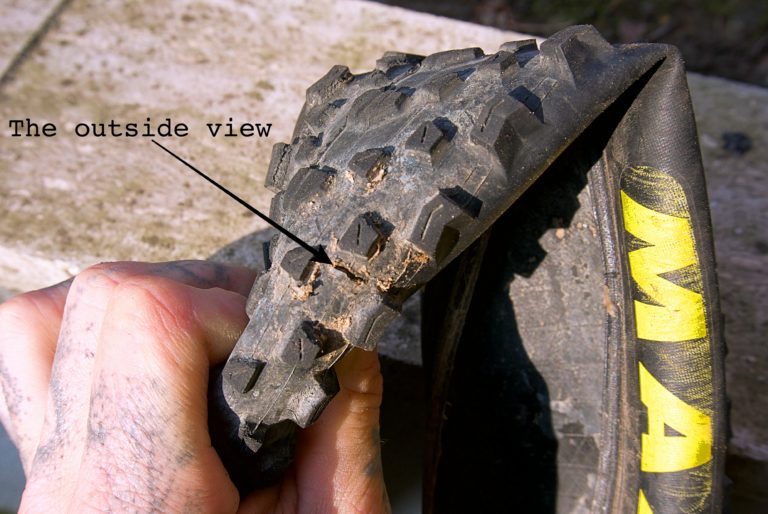
The Wolf Tooth Encase Bar Kit One is a handy toolkit that stashes in your bar ends. One side has a multi-tool and the other has a chain breaker and a threaded cap that reveals a tubeless tire plugger, as well as a hollow chamber containing a five-pack of small tubeless plugs. It works similarly to a standard miniature plugger tool and uses the same plugs. Read our review here. You can find the Bar Kit One at some bike shops or buy one online for $120.
Similar to the Wolf Tooth Encase, OneUp’s EDC Pump and Tool has a small cylinder with a threaded cap. On the inside of the cap is a tubeless repair tool and the cylinder has enough room to store a dozen plugs. The EDC Pump is one of the best we’ve used and having the tool and tubeless repair kit all inside makes it a no-brainer for day rides or bike trips. Read our review here. The full EDC system isn’t cheap. You have to buy three different components: the pump for $59, the Tool for $59, and the Plug and Pliers Kit for $39.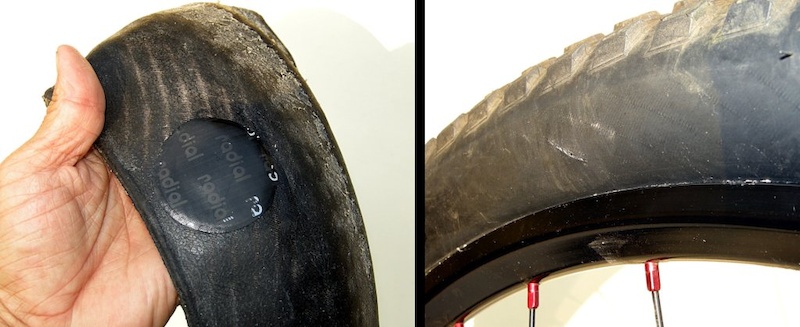 But, we’ve been using one regularly for several years and have zero complaints.
But, we’ve been using one regularly for several years and have zero complaints.
The Lezyne tubeless repair kit features an oversized repair fork and oversized plugs. These are double the size of typical tubeless plugs, so certainly better for larger holes and tears. Lezyne plugger retails for $19.99.
As part of Granite Designs’ Stash Tool line, the Stash Tire Plug uses an expandable rubber plug and aluminum cap to tuck away in the end of your handlebar. An aluminum sleeve houses a fork-style applicator, reamer, and four tire plugs, providing a sleek and easily accessible home for all of your tire plugging needs. Read our review here.
While other pluggers, such as the Dynaplug or typical “bacon strips,” are designed to wedge sticky rubber strips into a puncture, the DART’s plugs feature a hackle of specially designed material that’s engineered to create a chemical reaction with Stan’s sealant to quickly form a permanent airtight bond. We’ve yet to try the Dart, but will update this if we do. The Dart retails for $25.
We’ve yet to try the Dart, but will update this if we do. The Dart retails for $25.
The Sahmurai Sword (named after the creator Stefan ‘Sahmurai’ Sahm) uses a unique twist-to-lock design, replacing your bar end plugs with two impact-resistant rubber tools: one reamer and one fork-style applicator. The plug itself is held by the applicator within the bar, which means extra plugs must be carried elsewhere. Learn more over at Sahmurai.com.
One roadblock to tubeless for a lot of people is traveling with your bike—particularly travel that involves flying. For the most part, you can set your bike up tubeless beforehand, and simply add a little extra sealant and inflate your tires upon landing. Away from the comforts of your workshop or local bike shop, this might seem challenging, but with the right rims and tires, and a little preparation, it’s actually pretty easy. Here are a few tips we’ve learned over the years.
It’s never a good idea to start a big bikepacking trip on fresh tires, regardless.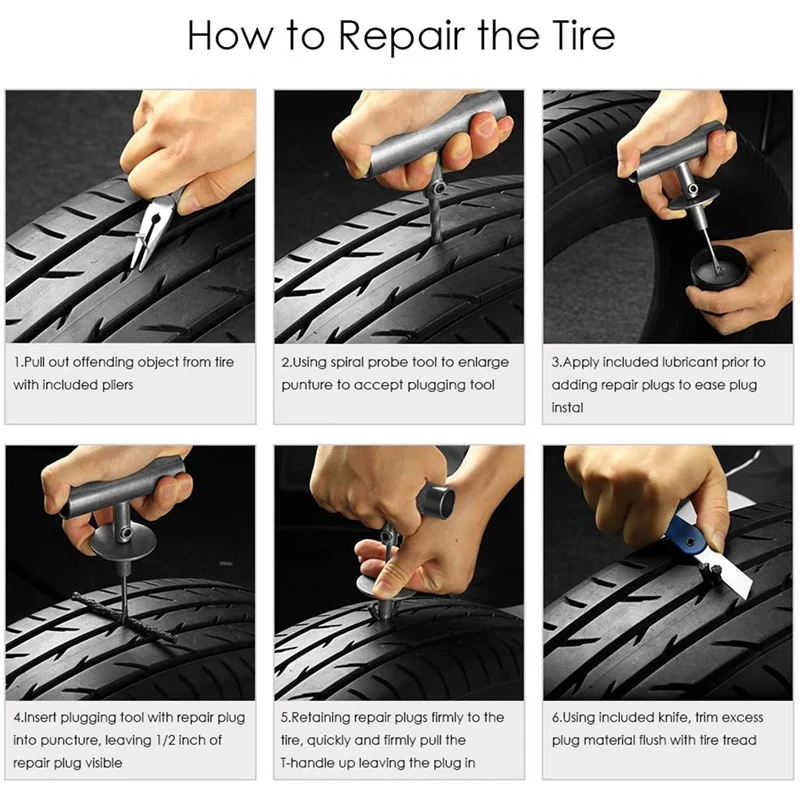 Tires can sometimes have defects, so giving them a proper test beforehand is always a good idea. This also ensures a proper tubeless seal. Four or five good rides can help get the sealant in all the right places.
Tires can sometimes have defects, so giving them a proper test beforehand is always a good idea. This also ensures a proper tubeless seal. Four or five good rides can help get the sealant in all the right places.
For trips that require travel, one method we’ve used in the past is to be conservative with the amount of sealant you use initially. This isn’t necessary, but it saves a mess if your tire seals break in transit. If you choose to go this route, bring extra sealant to add to it once you arrive at your destination. As an example, for two 29+ bikes, we found that one 16oz bottle of Orange Seal, one 4oz injector kit, and a spare empty 4oz bottle did the trick for adding sealant upon arrival and ensuring enough backup sealant for a two-month trip.
If you’re flying with your bike, let most of the air out of the tires, as required by most airlines. Be sure not to completely deflate the tire though, to protect your rims, and minimise the chance of the bead unseating. When you box your bike, rotate the wheels to make sure the wheels are rotated so that the valves are at the top—this will prevent sealant from settling in the valve and clogging the core.
When you box your bike, rotate the wheels to make sure the wheels are rotated so that the valves are at the top—this will prevent sealant from settling in the valve and clogging the core.
If your bead seals get broken in transit, you’ll have to repeat the set up procedure from the comfort of your hostel or hotel. Inflate with a mini pump (as mentioned above, we highly recommend a high volume pump like the 100cc OneUp EDC, or Lezyne’s Micro-Floor Drive HV). If you’re having a hard time getting the bead to push into place while pumping vigorously, try working the bead against the bead-lock lip. Sometimes it helps to have a friend hold the wheel off the ground, while an extra pair of hands can also help move the bead toward the rim while you’re pumping. If such hands aren’t available, we’ve also found that two Surly Junk Straps to cinch the tire into place can really help. Failing this, a trip down a local mechanic with a compressor should do the trick.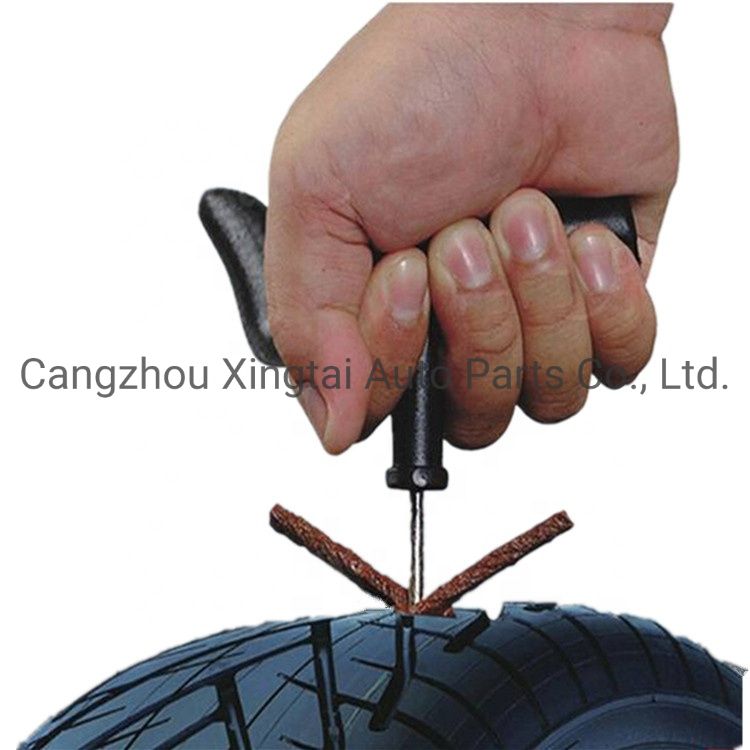 When the tire is inflated, check that it’s seated evenly. Extra pressure will generally encourage it to snap into place. If not, deflate, moisten the bead with soapy water, and try again.
When the tire is inflated, check that it’s seated evenly. Extra pressure will generally encourage it to snap into place. If not, deflate, moisten the bead with soapy water, and try again.
Have any tubeless repair tips or tricks to share? Or stories from the road? Leave us a comment below…
Please keep the conversation civil, constructive, and inclusive, or your comment will be removed.
Modern passenger cars are equipped with tubeless tires. Tires with rubber chambers inside are extremely rare today, only on super-budget vehicle options. Car owners have long appreciated all the convenience and benefits that tubeless tires have. Unlike chambered rubber, they keep air in the wheels by being sealed to the rim. The tightness of tubeless tires is ensured by a two-millimeter layer of rubber applied to the tire from the inside. It is he who prevents the passage of air. The coating of soft rubber layer provides tightness at the junction of the tire with the rim of the rim. The tire bead sits on the so-called rim shelf, which is equipped with a special rounded ledge. Thanks to him, the tire is securely connected to the wheel rim, and complete tightness of the joint is achieved. A tubeless tire is filled with air through a valve installed on the rim, on its rim. nine0003
It is he who prevents the passage of air. The coating of soft rubber layer provides tightness at the junction of the tire with the rim of the rim. The tire bead sits on the so-called rim shelf, which is equipped with a special rounded ledge. Thanks to him, the tire is securely connected to the wheel rim, and complete tightness of the joint is achieved. A tubeless tire is filled with air through a valve installed on the rim, on its rim. nine0003
Why did tubeless tires become so popular that they gradually replaced tubed tires? First, tubeless tires are much lighter. This is a very important and great advantage, because heavy weight enhances the inertial movement of the wheel when driving on, to put it mildly, imperfect road surfaces, which we still have much more than smooth autobahns. As a result, this affects the condition of the chassis, accelerates its wear. In addition, tubeless tires do not heat up during driving in the same way that chamber rubber heated up, in which the inner cylinder rubbed against the tire while driving.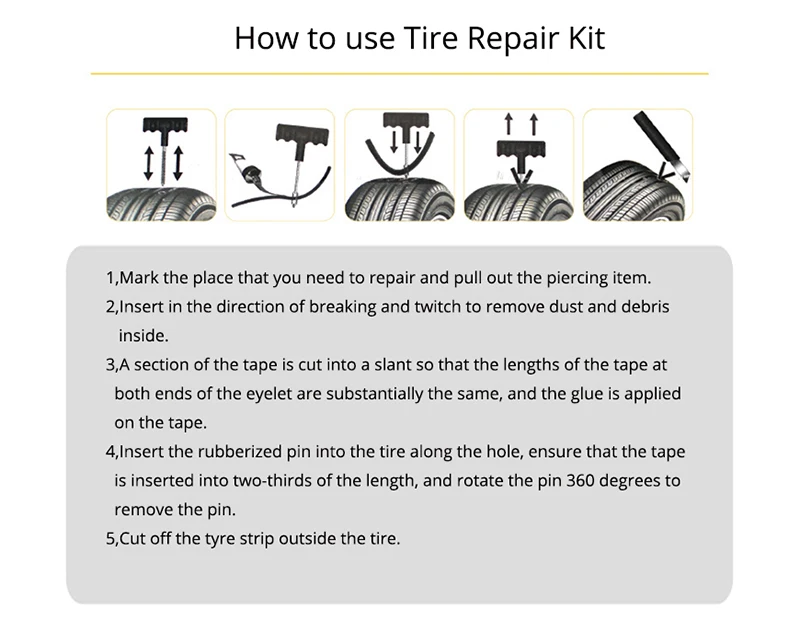 Such friction led to its rapid wear, and also increased the likelihood of tire rupture during movement. When a tube is punctured, the tube tire loses air very quickly, since it escapes not only from the puncture site, but also through leaky tire beads that do not fit snugly against the rim flange. In addition, if such a tire is punctured, you will not be able to stop the car immediately, it will travel more than a dozen meters by inertia until it comes to a complete stop. During this time, the tube and the tire can be damaged more thoroughly, the rubber of the inner cylinder will “chew”. With tubeless tires, this option is excluded. Even if a puncture occurs, thanks to the tightness of the chamber and its periodic pumping, you can get to the tire service. nine0003
Such friction led to its rapid wear, and also increased the likelihood of tire rupture during movement. When a tube is punctured, the tube tire loses air very quickly, since it escapes not only from the puncture site, but also through leaky tire beads that do not fit snugly against the rim flange. In addition, if such a tire is punctured, you will not be able to stop the car immediately, it will travel more than a dozen meters by inertia until it comes to a complete stop. During this time, the tube and the tire can be damaged more thoroughly, the rubber of the inner cylinder will “chew”. With tubeless tires, this option is excluded. Even if a puncture occurs, thanks to the tightness of the chamber and its periodic pumping, you can get to the tire service. nine0003
Tubeless and tube tires also differ in how they are mounted / dismantled. If chambered rubber can be freely disassembled or, conversely, installed at home, then such a number will not work with a tubeless one - the risk of damaging the side flanges is too high, damage to which will lead to depressurization of the tire.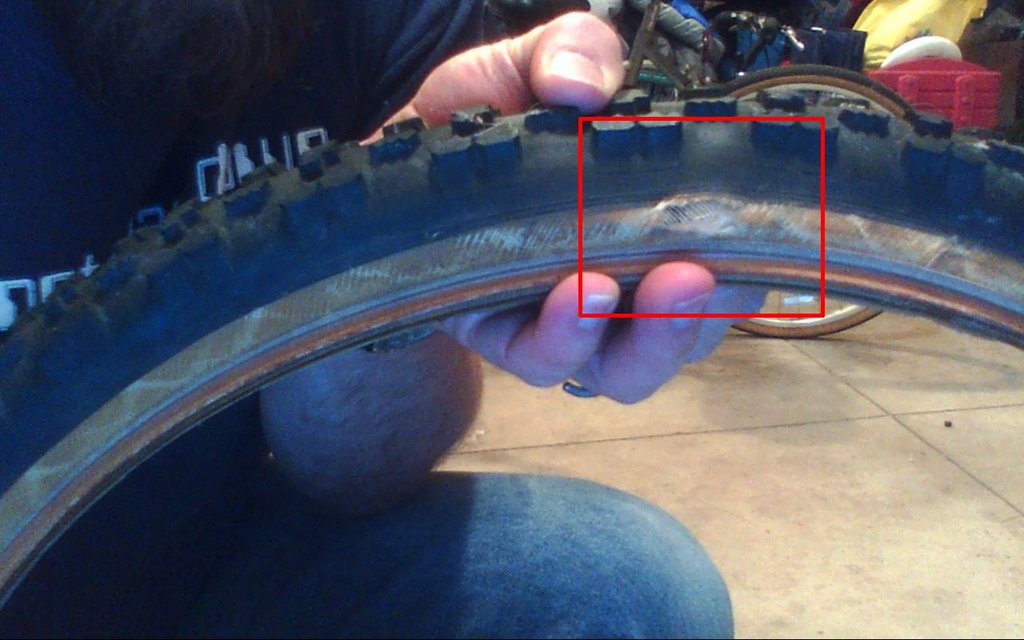 Due to the peculiarities of installation and dismantling, many motorists find it impossible to repair a tubeless tire with their own hands, especially on the road, not in a comfortable garage, but on the side of the road. And in vain. Of course, it will not be possible to completely eliminate the problem at a professional level without special equipment. But to make sure that the damaged tire still travels, and sometimes not only reaches the tire fitting center, but goes more than one hundred kilometers after an impromptu repair, is quite realistic. nine0003
Due to the peculiarities of installation and dismantling, many motorists find it impossible to repair a tubeless tire with their own hands, especially on the road, not in a comfortable garage, but on the side of the road. And in vain. Of course, it will not be possible to completely eliminate the problem at a professional level without special equipment. But to make sure that the damaged tire still travels, and sometimes not only reaches the tire fitting center, but goes more than one hundred kilometers after an impromptu repair, is quite realistic. nine0003
To do this, use special tire repair kits, which can be purchased everywhere today by going to any car shop. Better yet, buy everything you need to repair a tubeless wheel yourself separately and always have it ready. By doing this, you will save some money, which is always nice. The fact is that manufacturers of ready-made repair kits, in an effort to make their kits more expensive and solid in appearance, include in them both really useful tools and materials, as well as those that you can easily do without.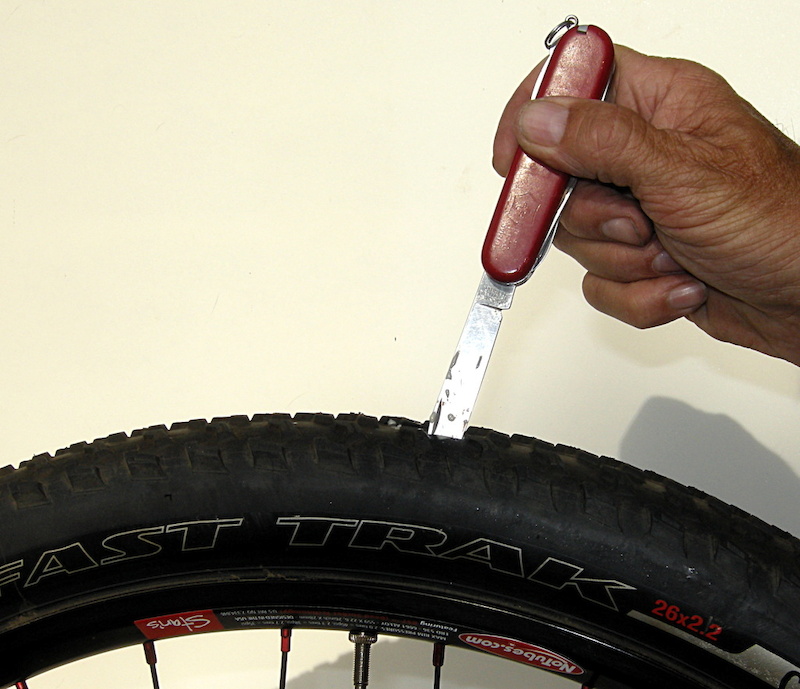 Using repair kits or separately purchased harnesses and tools, you can repair tubeless tires not only for cars, but also for trucks. This can also be regarded as one of the advantages of tubeless tires over tube tires. It is much more difficult to repair it with a puncture. It is necessary to disassemble the wheel, remove the chamber, find the puncture site, and then degrease the working area, cut out the patch, and seal the rubber balloon. After drying, the camera is installed in place, and the wheel is beaded. With a tubeless tire, everything is much easier. nine0003
Using repair kits or separately purchased harnesses and tools, you can repair tubeless tires not only for cars, but also for trucks. This can also be regarded as one of the advantages of tubeless tires over tube tires. It is much more difficult to repair it with a puncture. It is necessary to disassemble the wheel, remove the chamber, find the puncture site, and then degrease the working area, cut out the patch, and seal the rubber balloon. After drying, the camera is installed in place, and the wheel is beaded. With a tubeless tire, everything is much easier. nine0003
RUNWAY Tubeless Tire Repair Kit, 7-Piece
If you find that your car's tubeless tire wheel is damaged, first assess the severity of the situation. If, in your opinion, you can do without repair, having reached a reliable tire service on periodic pumping of the wheel, then it’s better to do so. Tubeless tires were designed to hold air even with foreign objects sticking out of the cord. But do not forget that riding with a nail or other object in the tire causes the puncture to gradually expand and the tire around the damaged area begins to gradually collapse. nine0003
But do not forget that riding with a nail or other object in the tire causes the puncture to gradually expand and the tire around the damaged area begins to gradually collapse. nine0003
But, if it so happens that the damage to the wheel received on the road is too extensive, the chamber does not hold air and it will not be possible to complete the journey while inflating the tire, you need to choose the best method of temporary repair and start it immediately. A tubeless tire is repaired in the following ways:
When choosing a repair using a tourniquet, you need to decide what type of material will be used. The harness can be cord or rubber. Let's consider both of these options. nine0003
Wheel repair kit, 6 pieces
Cord harness has found wide distribution as a repair material for tubeless tires. With this harness, you can carry out repairs in any conditions: on a city street or on the side of a country road. It is a strip of high-strength nylon, which is richly impregnated with high-quality rubber-based adhesive. Such harnesses are supplied to the domestic market by many manufacturers, they have certain differences in technical characteristics and cost. But all cord harnesses are installed according to the same type of scheme: nine0003
It is a strip of high-strength nylon, which is richly impregnated with high-quality rubber-based adhesive. Such harnesses are supplied to the domestic market by many manufacturers, they have certain differences in technical characteristics and cost. But all cord harnesses are installed according to the same type of scheme: nine0003
First of all, they find the place of damage and mark it with wax crayon or another marker.
Remove the item that damaged the tire if it is stuck in the cord.
Then you should check the tire pressure, it should not fall below 0.5 atmospheres.
Take a spiral awl and use it to determine at what angle the tire is damaged. nine0003
Apply vulcanizing glue to the awl.
Using the awl inserted into the puncture, coat the puncture site with glue in the most thorough way, for which you need to rotate the tool lubricated with it clockwise. Perform this action three times - lubricate the awl and insert it into the puncture, then leave the tool in the cord for the time being.
Perform this action three times - lubricate the awl and insert it into the puncture, then leave the tool in the cord for the time being.
Insert the tourniquet into a special needle, focusing on the center.
On both sides, cover the surface of the tourniquet with vulcanizing glue.
Remove the helical awl from the tire where you left it at the puncture site.
nine0038Install a pen with a needle and a tourniquet placed inside into the puncture.
By pressing the handle, install the needle with the tourniquet into the puncture, advancing to the stop at a given angle.
Remove the pen with the needle from the puncture site without rotating it.
Carefully cut off the parts of the tourniquet sticking out on the surface. nine0003
nine0003
Then you need to determine how tight the tire is repaired. This can be done with the help of a special liquid, which is used to determine the puncture site. If, after applying such a liquid, no air bubbles appear, then the tire is temporarily repaired and can be used further. If air bubbles appear, try installing an additional tourniquet in the place of damage to the tire.
This method of temporary repair is inexpensive, but it has proven its effectiveness more than once. A tire repaired in this way without repair will serve you for a long time - up to 6 months. nine0003
A rubber harness costs more than cord, but it is also more reliable. They install it in much the same way as the cord one, but there are still some differences. For example, when installing a rubber band, do not use an awl in the form of a rasp, since it can damage the rubber band during installation. In addition, the rubber band must be mounted on the adhesive specified by the manufacturer in the instructions for the repair kit.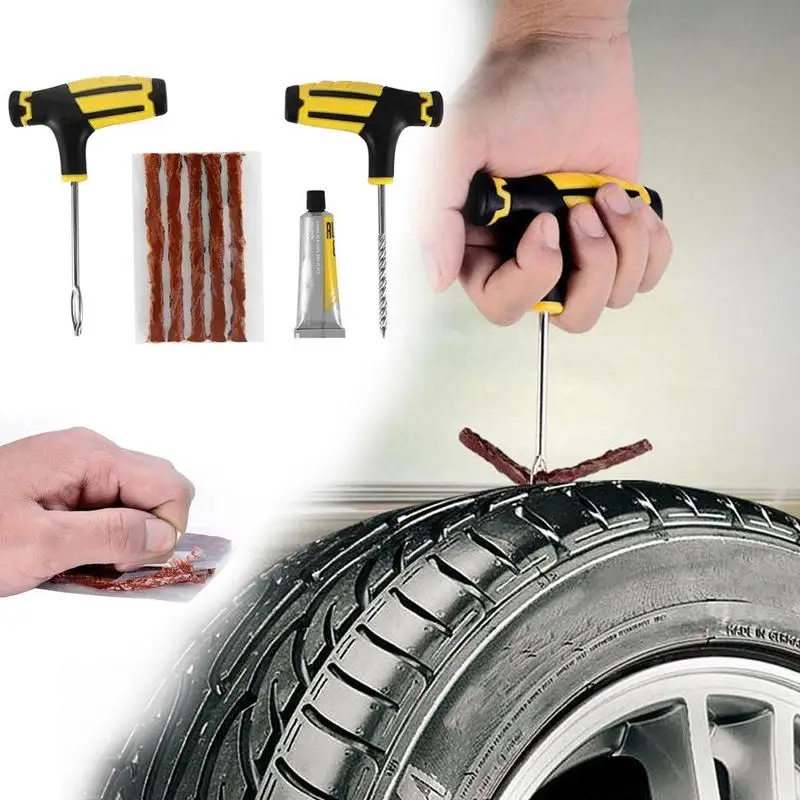
Raw rubber band for repairing RUNWAY tubeless tires, 5 pcs
In this case, an anchor is a special type of bundle, one end of which ends with a small patch. The anchor is installed in the same way as other types of harnesses, but in addition, it glues the puncture site with an internal patch. To do this, the tourniquet is pushed inward, and then pulled a little in the opposite direction. Anchor can only be installed using a special cutter with a diameter of 6 mm. It is purchased separately from the set. But your efforts will surely be crowned with success, because the anchor is considered the most reliable option for repairing a tubeless tire with a harness. But with the help of harnesses, you can not repair side punctures. And in any case, even if the repair is successful, it is necessary in the coming days to choose the time to visit the tire service. Remember that prolonged use of the harness will cause irreversible damage to the tubeless tire. And until the problem is fixed, constantly monitor tire pressure. nine0003
And until the problem is fixed, constantly monitor tire pressure. nine0003
The second option for repairing tubeless tires involves the use of sealant. This option cannot be called optimal, but it has become widespread, since tire repair in this way is carried out very quickly, literally in a matter of minutes. And the result of its implementation is guaranteed to allow you to get to the intended purpose of the trip, without first stopping by the tire service you met along the way.
The sealant is very easy to apply. In this case, it is not necessary to remove a nail or other object from the cord, due to which the tire was damaged. Simply attach a bottle filled with sealant to the valve on the rim of the wheel and see that the contents of the bottle are pumped into the wheel. Keep in mind that repairing a tire with sealant will significantly disrupt the balance, so choose a moderate speed. But on the other hand, repairs with the help of a sealant are easy, simple and very fast.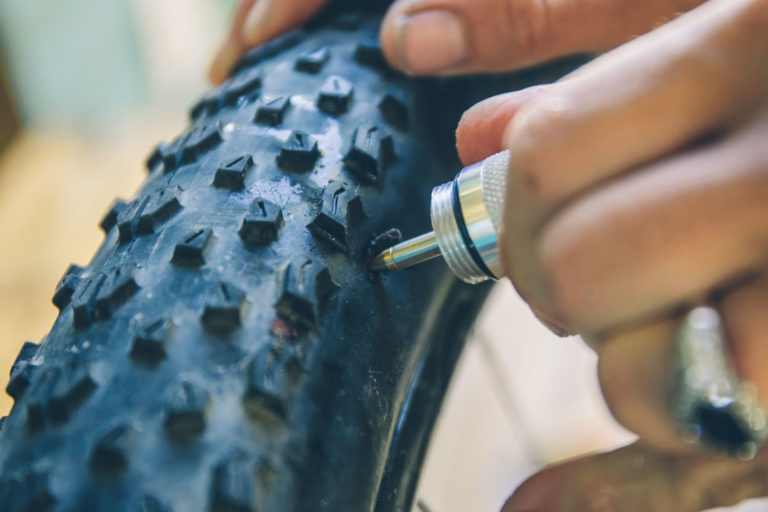 You can use it even while standing in a traffic jam. nine0003
You can use it even while standing in a traffic jam. nine0003
Today, you can easily buy different types of sealants. The most widely used gel, liquid, aerosol formulations. Gel ones are good because they can be used all-season, both in the summer heat and in the cold season. But at the same time, they significantly worsen the balance of the wheel. Liquid sealants are highly reliable, but they are not very convenient to use. Aerosol compositions make it possible to restore the performance of the wheel without a jack and a pump. But in the cold winter period, they will not work. If we compare the restoration of a tubeless tire, carried out with the help of sealants and harnesses, cord or rubber, then the latter are considered the preferred option, since they provide a fairly high quality of the repair performed with their help. nine0003
As you can see, do-it-yourself tubeless tire repair is possible, albeit temporary. You just need to stock up on funds for its implementation, without delaying the purchase of harnesses or sealant, because a lot of trouble awaits us on the roads. Meet them fully armed and quickly solve the problem. For guaranteed success, you must strictly follow the recommendations given by the manufacturer of repair materials in the instructions for use.
Meet them fully armed and quickly solve the problem. For guaranteed success, you must strictly follow the recommendations given by the manufacturer of repair materials in the instructions for use.
Car repair,
Each of the drivers may have such a situation when a tubeless tire deflated on the way, but the spare tire was not in the car, or this is already the second wheel for a long road. In this case, there are only two ways out - one way or another, wait for help from others (take the wheel to a tire fitting, call to bring a spare tire, call a tow truck, etc.), or you can repair a punctured tire yourself.
Before moving on to the very topic of the question, it is worthwhile to carefully study all aspects of the operation of tubeless tires, but their widespread use has clearly proved that they have a clear advantage over tube wheels.
The main advantage for the driver is the ease of repair, because if a wheel with a chamber is punctured, it will have to be removed and disassembled in order to remove the chamber, and only then carry out the repair itself, and then you will have to do laborious work (if it is done without special equipment) in reverse order. Tubeless tires, in most cases, can be repaired without dismantling the wheel, and without even removing it from the car. nine0003
In addition, when punctured, a tubeless tire deflates for a long time, and sometimes drivers ride with several nails or self-tapping screws in the wheel without noticing the problem for up to several months. Therefore, if necessary, you can pump up a wheel with a puncture and have time to get to the nearest tire service.
However, there are several nuances that complicate operation. For example, with a strong impact on the edge of a pit or a curb, the tire can depressurize and instantly deflate, or if the wheel is not completely deflated, it can disassemble during a turn, which will lead to an instant descent.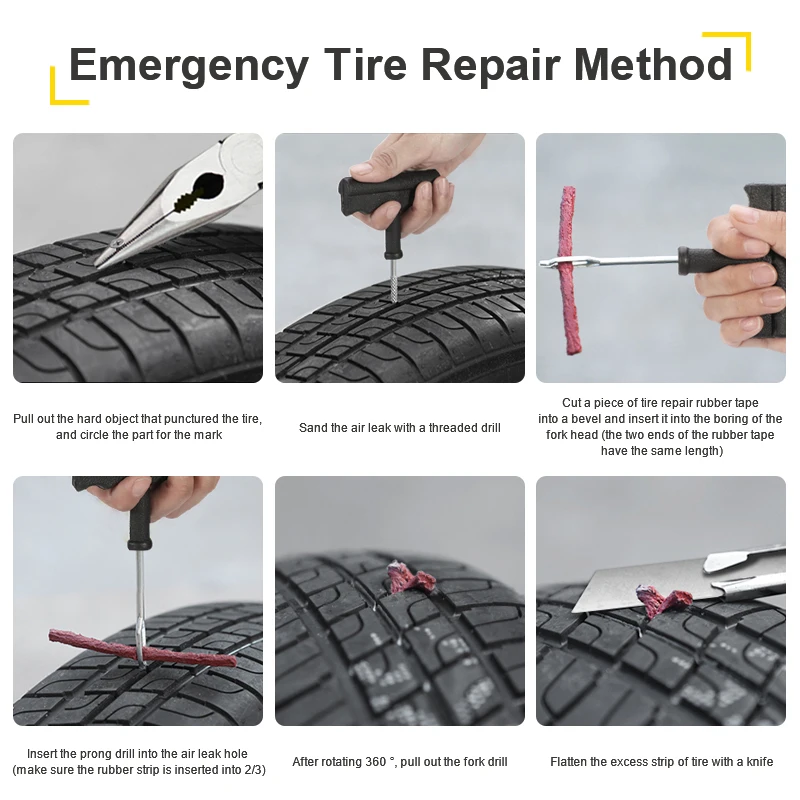 nine0003
nine0003
Also, such a wheel is very difficult to inflate with a conventional pump or a mobile compressor, if it is disassembled (flew off the disk), in this case a professional compressor with high pressure is needed.
Usually, this procedure is not too difficult, and the puncture site is easily detected by visual inspection due to the culprit of the damage, which remains in the tread.
Alternatively, a soapy solution of any soapy liquid or plain water may help. By pouring on the tire with our “puncture indicator”, you can quickly find the required place by the emerging air bubbles. nine0003
But in the case when there is no soap or water, you have to carefully inspect the tire, while listening to hissing and trying to find the puncture site with your hand. This method helped me repeatedly in deaf and deserted places.
Using a special sealant for repairing tubeless tires is the easiest and fastest way to repair a wheel and get to a professional tire shop.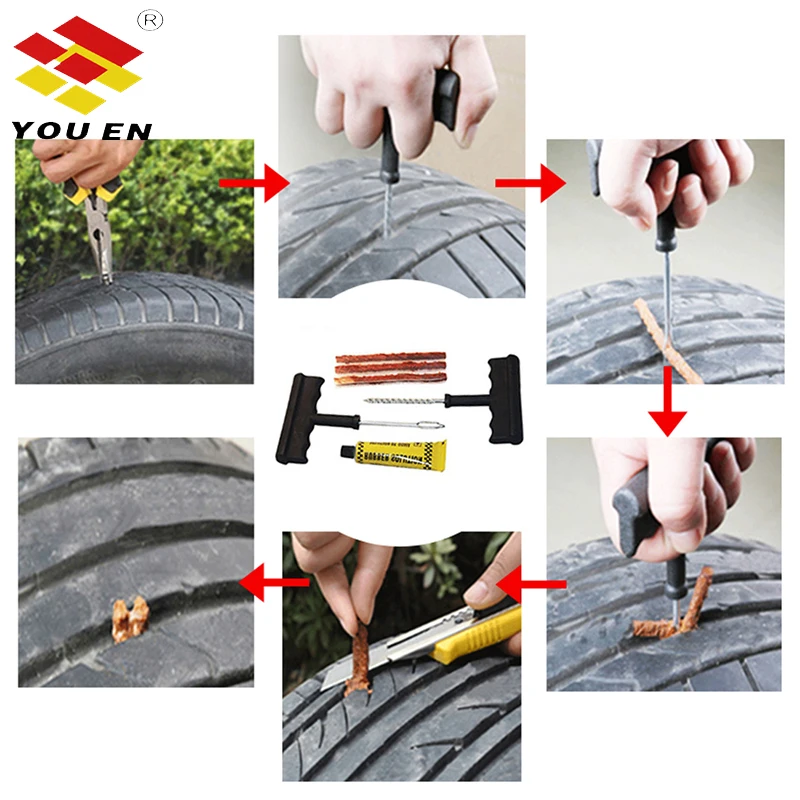 If you do not have such a can, then we advise you to buy it, sooner or later - it will save your nerves, time and mood. nine0003
If you do not have such a can, then we advise you to buy it, sooner or later - it will save your nerves, time and mood. nine0003
And so, if there is a nail or screw left in the tire, then it should not be removed immediately, first we connect the bottle with sealant to the nipple and if the bottle is new, then we completely inflate the wheel, if there is already insufficient pressure left in it, then before repair will need to pump up the wheel to at least 1 atmosphere.
After the sealant is pumped into the wheel, it is necessary to remove the foreign object, and the sealant under air pressure will seal the puncture site from the inside, but remember that this method of repair is temporary, and it will last for about 100 km, which is enough for a visit tire fitting. nine0003
It should also be remembered that the use of sealant disturbs the balance, and you cannot drive fast on such a wheel, the safest speed will be about 60 km / h.
This method is the most correct for emergency road repairs.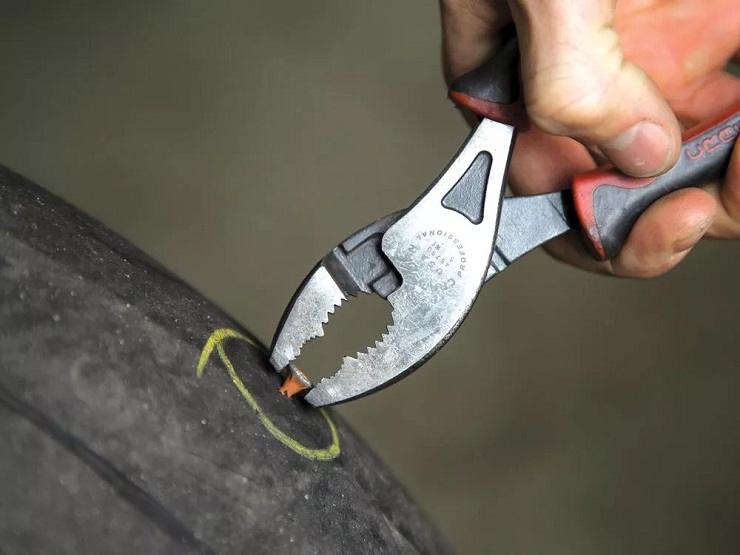 Similar kits are sold in any automotive store, and even in any large supermarket. The kit usually includes a special awl to expand the puncture, a hook for the lace, the laces themselves with bituminous impregnation and, in some cases, glue. nine0003
Similar kits are sold in any automotive store, and even in any large supermarket. The kit usually includes a special awl to expand the puncture, a hook for the lace, the laces themselves with bituminous impregnation and, in some cases, glue. nine0003
Before carrying out repairs, in order not to spoil the integrity of the cord (the inner hard part of the wheel made of steel wire and nylon thread), it is worth reducing the pressure to 1 atmosphere. Then you should use an awl to clean and widen the hole, without which you will not be able to insert the lace. But you should not immediately remove the awl from the hole, otherwise the tire will release all the pressure and insert the lace will not work.
Then you should put the cord into the eye of the hook, distributing it equally on each side, after which the awl is taken out and the hook with the cord is put into the hole formed, here you should treat the action carefully and not overdo it. The lace should go into the tire about half or a little more (the sealing harness should be folded in half).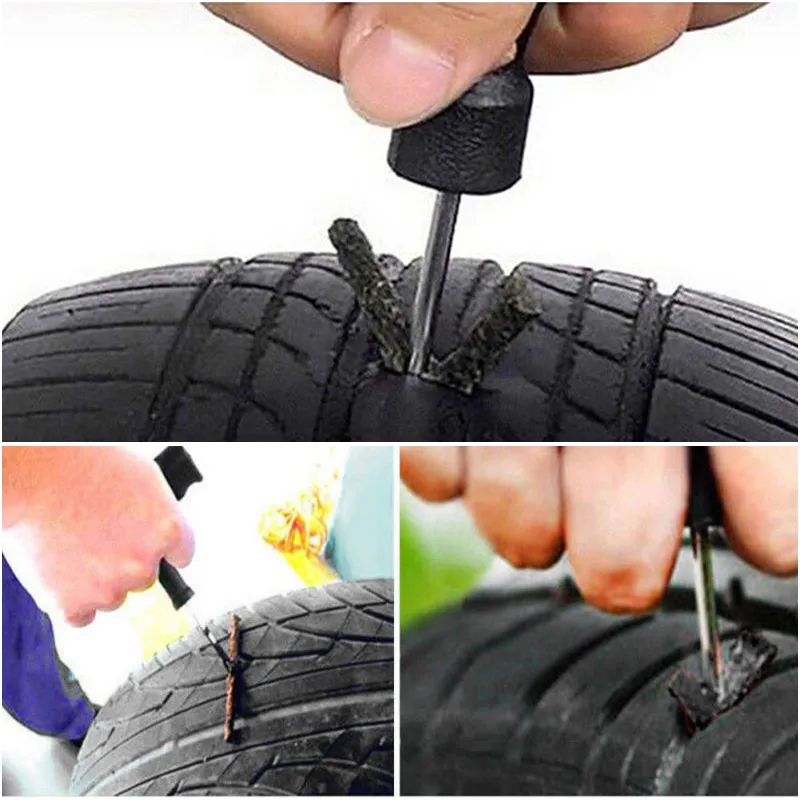 nine0003
nine0003
After that, it is necessary to pull out the hook with one sharp movement, while the tourniquet will remain in the tire. Repair can be considered completed after cutting off excess pieces of lace and pumping the wheel to the required pressure.
It is worth noting that when using high-quality sets, this repair is considered to be complete and the puncture will be securely closed until the end of the wheel's service life. The only thing that may be required is balancing.
However, if the damage to the wheel is serious, then you will have to take care of buying a new tire. Recall that it is forbidden to repair cuts on the wheel, such a wheel is no longer allowed for operation even as a spare. Therefore, it is better to choose a cheaper tire than to pay for the repair of a cut, especially since today you can choose a new wheel even through your phone or from your home computer by visiting a specialized website.